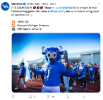
Using UB Hashtags
Using UB’s hashtags in your social media content has many benefits. By leveraging these hashtags consistently from all official UB accounts, we allow our community to more easily find our content. This not only amplifies our content's reach, but allows other members of the UB community - especially those who may not yet be following your account - to easily see your posts (and potentially share them).

#UBuffalo is UB’s primary hashtag. Use this hashtag on ALL posts to reach our UB community.

#UBhornsUP is UB’s spirit hashtag. Use this for athletics posts, or to convey pride.

#UBTrueBlue is our community hashtag. Use this to convey pride as a member of the UB community.
For examples on how to use each hashtag, refer to the photo gallery below:
Best practices for hashtags vary on each social media channel, but generally, should be leveraged to better reach not only our UB community, but also those interested in a given subject matter. To do so effectively, follow these best practices:
Use multiple UB hashtags:
- While #UBuffalo should be used on ALL social media posts, on all channels, you can (and should) use it in conjunction with other UB, campaign or unit hashtags as appropriate to the content. Keep character limits and channel best practices in mind, but don't be afraid to use two UB hashtags in a given post.
Leverage topical hashtags to increase reach, when appropriate:
- Leverage topical hashtags with a large reach (in conjunction with the UB hashtags on this page) to ensure that your content is seen by others interested in a given subject matter. Just be sure you know the meaning and origin of the hashtags you use and are prepared to be part of that conversation.
- On some channels, you may be able to use multiple topical hashtags in a post to increase reach without it affecting performance. On other channels, like X/Twitter, where characters are limited, you may need to select one topical hashtag that best captures the focus of the content.
- Note: There may be instances where you do NOT want to include a topical hashtag on your post. This may be because the content is intended only for an internal audience OR because the content is sensitive and could attract unwanted attention. Consider whether you want a post to have increased reach before using topical hashtags.
If your content celebrates or impacts WNY , consider using either #Buffalove or #BuffaloNY (or both) to reach more people in the community and build pride locally.
Use CamelCase:
- When using hashtags that contain multiple words, use CamelCase whenever possible to help make your hashtags more accessible and scannable. CamelCase refers to the practice of capitalizing the first letter of each word to help the user easily see when a new word has started and avoid unintended double meanings (e.g. use #IndustrialEngineering instead of #industrialengineering).
There may be instances when a campaign or initiative-based hashtag is needed for your unit.
Creating a new hashtag is only advisable when your product or campaign will have a long life, be promoted in other media (e.g. print, flyers, broadcast) or has proven wide recognition.
When creating a hashtag, be sure to follow these recommendations:
Make sure you can 'own' your hashtag
- To avoid your content being lost or mixed in with content from other organizations or entities, make sure it is unique. To do this, brand your hashtag by incorporating either UB or UBuffalo (UBuffalo is generally preferred as there are many schools/organizations that utilize the acronym UB) into the hashtag, so that you are only seeing content from the UB community, as intended.
- An easy way to test this and find out if the hashtag you are creating is unique is to search it in X/Twitter and Instagram. If no results come up, then you know you’ve selected a hashtag that you can ‘own.’
Avoid acronyms as much as possible.
- The average person will not know what they mean. Additionally, generic hashtags that use acronyms are more difficult to 'own' – meaning, that you are going to have to dig through a lot of unrelated content because there are other entities using those acronyms. For example, using #UBTB doesn't convey a lot information to a user and could be leveraged by almost any organization. However, by spelling it out and using #UBTrueBlue instead, you provide much more context for your audience.
Use dates strategically.
- The purpose of hashtags are to reach as many users as possible. By incorporating a year or date into a hashtag, you limit that reach by having to create a new hashtag annually and build awareness around the new hashtag each time. However, incorporating dates may be strategically important for initiatives that are specific to dates, like commmenement, where you may want to create unique hashtags for each class so they can easily find the content at a later date.
Use it in conjunction with #UBuffalo.
- Utilizing the #UBuffalo hashtag in your posts WITH your campaign or unit hashtag allows you to reach the entire university community and should help get more visibility.
DON’T Use #UB, #Universityatbuffalo, #SUNYatBuffalo or other versions of UB’s name.
- #UB is used by many other entities and is therefore not unique to UB
DON’T Use #hornsup
- The horns up hand gesture is ubiquitous. You can see it everywhere from sports events to music videos. Likewise, the #hornsup hashtag is used widely in social media. By using UB’s version of “horns up”—#UBhornsUP—we can better find the content and control the context in which we appear
DON’T Use #HereisHow
- It is not a tagline—it’s merely shorthand for the way we tell our stories. It’s not unique to UB so we can’t control the context. It is used widely, and in some negative contexts. Using it puts us in bad—or irrelevant—company
DON’T Use the UB acronym to form words
While incorporating the UB acronym into a hashtag is permissible, avoid using it in place of the words ‘you be’ (e.g. ‘#WillUBThere, #UBecome’) or form other words (e.g. #scrUBs)


